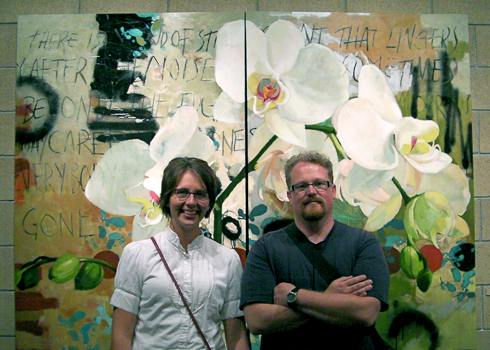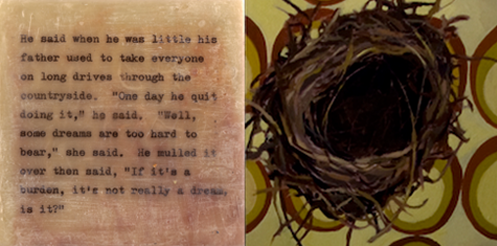I recently spent a couple of days in Salt Lake for the opening of a show I did with Utah painter, Jennifer Rasmusson. I've been mentioning this project for the last few weeks on Facebook and Twitter. Jennifer and I have been wanting to collaborate for a couple of years, and eventually one of the galleries that represents her agreed to the experiment. It was really one of the most enjoyable and challenging things I have ever done with my writing in a long time.
 The process began a couple of months ago. We shared our work and had a few long conversations about what was possible. After those first meetings, we set a few ground rules. First, we didn't want to create the show around the idea of illustration; the images and words had to be on an equal footing and not duplicate each other too much. Second, we wanted to influence each other so that we all wound up in a new place. And third, we wanted to explore the relationship of reading and looking, which is a really complicated matter, one I am really interested in looking into a little more deeply.
The process began a couple of months ago. We shared our work and had a few long conversations about what was possible. After those first meetings, we set a few ground rules. First, we didn't want to create the show around the idea of illustration; the images and words had to be on an equal footing and not duplicate each other too much. Second, we wanted to influence each other so that we all wound up in a new place. And third, we wanted to explore the relationship of reading and looking, which is a really complicated matter, one I am really interested in looking into a little more deeply.
Once I had written a few of the prose pieces, we started thinking about how to represent the writing so that (a) it would present itself as something to be read, and (b) it would seem like a painting and not a book, zine, or other printed matter. We naturally went first to the idea of letterpress, which looks great, but has the problem of "aura."
Aura was described by Walter Benjamin as the quality in a work that comes from its uniqueness as opposed to having been mass produced through mechanical means. Items that are one of a kind demand a different aesthetic response than ones that are reproduced or even commonplace. He would have had a ball with the internet.
In any case, we didn't want things to look printed, but we wanted them to have the look of type so that viewers would be encouraged to read them rather than to take the words as images without meaning attached to them. This led me to some interesting thoughts on something writers at one time or another have to really address. I might have been primed by Michael Chabon's recent interview with Teri Gross in which he discusses the idealized reader every writer has to construct, the entity who will get the jokes and puns and allusions the writer puts on the page.
Books are mass produced and distributed (many copies of one thing), and in the case of a blog, like this one, many readers are brought to a duplication taken from a single copy stored in a server, so that an infinite number of temporary copies exist at any one time.
In a gallery there is, however, only one painting. That is, I gather, the whole purpose of the gallery. Yes, paintings can be reproduced, but the whole thing about a gallery, the aura they are trying to create, is uniqueness. When you buy this painting, you're getting an exclusive deal—that's the arrangement the gallery is selling.
One other interesting thing I had to consider in working on these stories meant to be seen in a gallery and not read in a book, is that the gallery is a social environment, like a theater. The other people in the gallery, the other works adjacent to it, all exert a force on the reading. We don't read in a vacuum, but we do often read alone, or in pseudo-loneliness: on trains, in waiting rooms, or on flights.
 I got the first sense of these pressures on the night of the opening. We have one large collection of work called "The Conversation" in which we matched small paintings with small story paintings that consisted of a short bit of dialogue. Some dude came in and bought two of the stories, effectively splitting them from the context of their partner image. As he walked off with one of the gallerists, the small crowd of about ten people went into an outrage. They said things like, "You can't split them up, you just can't. Make him come back and buy the nest."
I got the first sense of these pressures on the night of the opening. We have one large collection of work called "The Conversation" in which we matched small paintings with small story paintings that consisted of a short bit of dialogue. Some dude came in and bought two of the stories, effectively splitting them from the context of their partner image. As he walked off with one of the gallerists, the small crowd of about ten people went into an outrage. They said things like, "You can't split them up, you just can't. Make him come back and buy the nest."
Then, the next day, the night of the gallery stroll, a man came in right as the gallery was closing. He looked like a speed metal A and R guy, drove a white BMW, and his girlfriend looked like a cross between a bond girl and a cocktail waitress at Caesar's Palace. He took a look at the large diptych of Jennifer's on which I had written a field of words in charcoal (pictured above). It sold early the night of the opening to a beautiful young woman and her hip husband, who also bought my favorite story/image combination.
This guy took one look at the little red dot that means the painting was no longer available and said, "Aw, shit, man. I wanted that one." He stuffed his hands in his pockets and then walked around the gallery and said, "Who bought it?" When he realized it was uncool to be asking that, he said, "You don't have to tell me." One gallerist named the couple. Our guy said, "Her? Dammit."
The amazing part about it, was the painting was still there and would be for the rest of the show, setting the aesthetic. The works which were off limits were still there, flaunting themselves. Except in the rare book market, there will always be many other copies of a book, so it's not a big deal. With a painting, there is one, and that creates a lot of desire, in that context. It's really interesting to watch those pressures at play.
Needless to say, this experience was not only interesting but slightly intoxicating. My wife (she and I collaborated on paintings—a future post on that is coming) and I left, wanting to create, and you can't ask for a better experience then that.